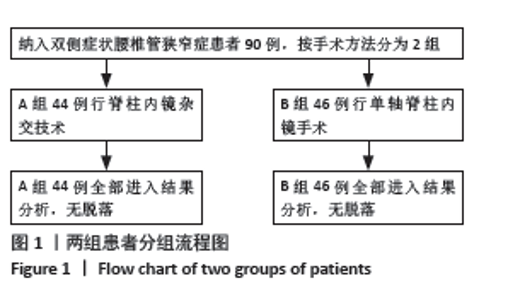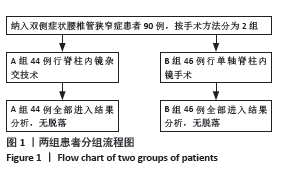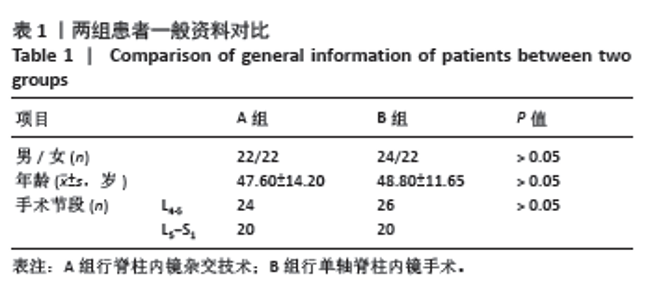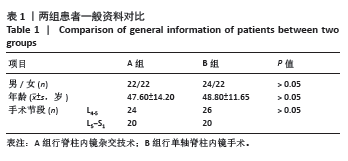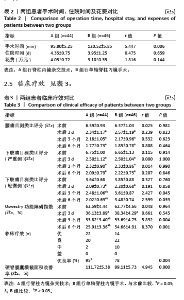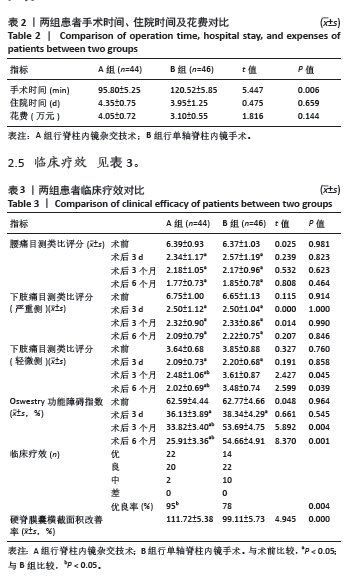Chinese Journal of Tissue Engineering Research ›› 2025, Vol. 29 ›› Issue (3): 517-523.doi: 10.12307/2025.106
Previous Articles Next Articles
Comparison of decompression effects between spine endoscopy hybrid technique and uniportal endoscopic surgery in treatment of lumbar spinal stenosis with bilateral symptom
Guo Song, Li Xinhua, Yan Meijun, Liu Yanbin, Liu Zhong, Li Kewei, Liu Pengcheng, Zhang Beiting, Fu Qiang
- Department of Spine Surgery, First People’s Hospital, Shanghai Jiao Tong University, Shanghai 200080, China
-
Received:2023-10-08Accepted:2023-12-15Online:2025-01-28Published:2024-06-03 -
Contact:郭松,男,1987年生,山东省新泰市人,2017年同济大学医学院毕业,博士,主要从事脊柱外科及脊柱微创智能技术的研究。 -
About author:Guo Song, MD, Department of Spine Surgery, First People’s Hospital, Shanghai Jiao Tong University, Shanghai 200080, China -
Supported by:National Natural Science Foundation of China, No. 82202694 (to GS); National Natural Science Foundation of China, No. 81971154 (to FQ); Clinical Research Innovation Plan of Shanghai General Hospital, No. CTCCR-2021C10 (to GS); Shanghai 2021 “Science and Technology Innovation Action Plan” Biomedical Science and Technology Support Project, No. 21S31901300 (to FQ)
CLC Number:
Cite this article
Guo Song, Li Xinhua, Yan Meijun, Liu Yanbin, Liu Zhong, Li Kewei, Liu Pengcheng, Zhang Beiting, Fu Qiang. Comparison of decompression effects between spine endoscopy hybrid technique and uniportal endoscopic surgery in treatment of lumbar spinal stenosis with bilateral symptom[J]. Chinese Journal of Tissue Engineering Research, 2025, 29(3): 517-523.
share this article
Add to citation manager EndNote|Reference Manager|ProCite|BibTeX|RefWorks
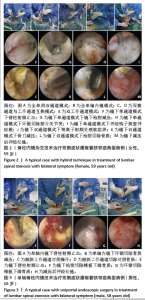
2.5.1 目测类比评分 两组术后3 d、3个月及6个月腰痛、症状严重侧下肢放射痛均较术前明显缓解,差异有显著性意义(P < 0.05);A组术后3 d、3个月及6个月症状轻微侧目测类比评分均较术前明显降低,差异均有显著性意义(P < 0.05);B组术后3 d症状轻微侧目测类比评分较术前明显降低,差异有显著性意义(P < 0.05);B组术后3,6个月症状轻微侧目测类比评分较术前均无明显降低。组间比较结果显示,两组术后腰痛及症状严重侧目测类比评分无差别(P > 0.05);A组术后3,6个月症状轻微侧目测类比评分明显低于B组(P < 0.05)。 2.5.2 ODI 两组术后3 d ODI均较术前明显降低(P < 0.05),组间比较两组术后3 d无差异;A组术后3,6个月ODI与术前相比明显降低(P < 0.05),B组术后3,6个月ODI与术前相比无明显差异(P > 0.05)。组间比较两组术后3,6个月ODI,A组明显低于B组(P < 0.05)。 2.5.3 改良Macnab优良率 A组优良率为95%,B组优良率为78%,两组比较差异有显著性意义(P < 0.05)。 2.5.4 硬脊膜囊横截面积改善率 A组硬脊膜囊横截面积改善率为(111.72±5.38)%,明显优于B组(99.11±5.73)%, 差异有显著性意义(P < 0.05)。 2.6 并发症 两组患者均未发生硬膜撕裂、神经根损伤及硬膜外血肿等并发症。 2.7 典型病例 见图2,3。"
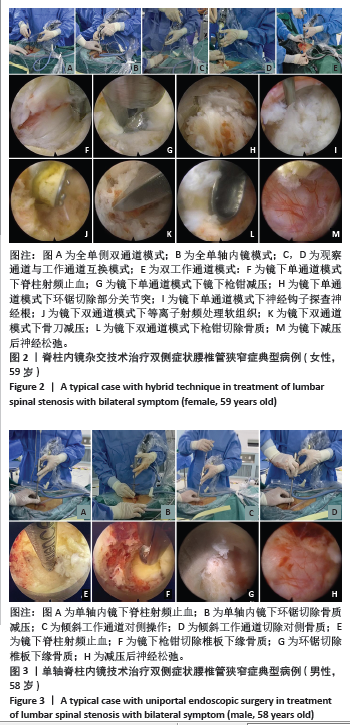
| [1] KATZ JN, ZIMMERMAN ZE, MASS H, et al. Diagnosis and management of lumbar spinal stenosis: a review. JAMA. 2022;327(17):1688-1699. [2] KARLSSON T, FÖRSTH P, SKORPIL M, et al. Decompression alone or decompression with fusion for lumbar spinal stenosis: a randomized clinical trial with two-year MRI follow-up. Bone Joint J. 2022;104-B(12): 1343-1351. [3] GADJRADJ PS, BASILIOUS M, GOLDBERG JL, et al. Decompression alone versus decompression with fusion in patients with lumbar spinal stenosis with degenerative spondylolisthesis: a systematic review and meta-analysis. Eur Spine J. 2023;32(3):1054-1067. [4] LI Z, WANG X, XIE T, et al. Oblique lumbar interbody fusion combined with stress end plate augmentation and anterolateral screw fixation for degenerative lumbar spinal stenosis with osteoporosis: a matched-pair case-controlled study. Spine J. 2023;23(4):523-532. [5] SILVA PS, JARDIM A, PEREIRA J, et al. Minimally invasive fusion surgery for patients with degenerative spondylolisthesis and severe lumbar spinal stenosis: a comparative study between MIDLIF and TLIF. Eur Spine J. 2023;32(9):3210-3217. [6] DIMITRIOU D, WINKLER E, WEBER S, et al. A simple preoperative score predicting failure following decompression surgery for degenerative lumbar spinal stenosis. Spine (Phila Pa 1976). 2023;48(9):610-616. [7] GAGLIARDI MJ, GUIROY AJ, CAMINO-WILLHUBER G, et al. Is indirect decompression and fusion more effective than direct decompression and fusion for treating degenerative lumbar spinal stenosis with instability? a systematic review and meta-analysis. Global Spine J. 2023; 13(2):499-511. [8] ALHAUG OK, DOLATOWSKI FC, SOLBERG TK, et al. Predictors for failure after surgery for lumbar spinal stenosis: a prospective observational study. Spine J. 2023;23(2):261-270. [9] DANTAS FL, DANTAS F, CAIRES AC, et al. Adjacent segment degeneration after posterolateral lumbar fusion: results and complications of posterior revision surgery. J Neurosurg Sci. 2023;67(4):446-453. [10] CHEN Z, ZHANG L, DONG J, et al. Percutaneous transforaminal endoscopic discectomy versus microendoscopic discectomy for lumbar disc herniation: two-year results of a randomized controlled trial. Spine. 2020;45(8):493-503. [11] LOKHANDE PV. Full endoscopic spine surgery. J Orthop. 2023;40:74-82. [12] CHEN KT, KIM JS, HUANG AP, et al. Current indications for spinal endoscopic surgery and potential for future expansion. Neurospine. 2023;20(1):33-42. [13] KANG MS, YOU KH, HAN SY, et al. Percutaneous full-endoscopic versus biportal endoscopic posterior cervical foraminotomy for unilateral cervical foraminal disc disease. Clin Orthop Surg. 2022;14(4):539-547. [14] JU CI, LEE SM. Complications and management of endoscopic spinal surgery. Neurospine. 2023;20(1):56-77. [15] BALAIN B, BHACHU DS, GADKARI A, et al. 2nd and 3rd generation full endoscopic lumbar spine surgery: clinical safety and learning curve. Eur Spine J. 2023;32(8):2796-2804. [16] WU PH, CHIN BZJ, LEE P, et al. Ambulatory uniportal versus biportal endoscopic unilateral laminotomy with bilateral decompression for lumbar spinal stenosis-cohort study using a prospective registry. Eur Spine J. 2023;32(8):2726-2735. [17] WANG L, LI C, HAN K, et al. Comparison of clinical outcomes and muscle invasiveness between unilateral biportal endoscopic discectomy and percutaneous endoscopic interlaminar discectomy for lumbar disc herniation at L5/S1 Level. Orthop Surg. 2023;15(3):695-703. [18] LI YS, CHEN CM, HSU CJ, et al. Complications of unilateral biportal endoscopic lumbar discectomy: a systematic review. World Neurosurg. 2022;168:359-368. [19] CHEN Z, ZHOU H, WANG X, et al. Complications of unilateral biportal endoscopic spinal surgery for lumbar spinal stenosis: a meta-analysis and systematic review. World Neurosurg. 2023;170:e371-e379. [20] ZHU C, CHENG W, WANG D, et al. A helpful third portal for unilateral biportal end08copic decompression in patients with cervical spondylotic myelopathy: a technical note. World Neurosurg. 2022;161;75-81. [21] 晏美俊,郭松,付强,等. 三种内镜手术技术治疗神经根型颈椎病的临床疗效比较[J]. 中国脊柱脊髓杂志,2023,33(7):610-618. [22] MARTIN BI, MIRZA SK, SPINA N, et al. Trends in lumbar fusion procedure rates and associated hospital costs for degenerative spinal diseases in the united states, 2004 to 2015. Spine (Phila Pa 1976). 2019;44(5):369-376. [23] DERMAN PB, OHNMEISS DD, LAUDERBACK A, et al. Indirect decompression for the treatment of degenerative lumbar stenosis. Int J Spine Surg. 2021;15(6):1066-1071. [24] YASAR B, SIMSEK S, ER U, et al. Functional and clinicalevaluation for the surgical treatment of degenerative stenosis of the lumbar spinal canal. J Neurosurg Spine. 2009;11(3):347-352. [25] IMAJO Y, TAGUCHI T, NEO M, et al. Complications of spinal surgery for elderly patients with lumbar spinal stenosis in a super-aging country: An analysis of 8033 patients. Orthop Sci. 2017;22(1):10-15. [26] SATO J, OHTORL S, ORITA S, et al. Radiographic evaluation of indirect decompression of mini-open anterior retroperitoneal lumbar interbody fusion: oblique lateral interbody fusion for degenerated lumbar spondylolisthesis. Eur Spine. 2017;26(3):671-678. [27] HAYAMA S, NAKANO A, NAKAYA Y, et al. The evaluation of indirect neural decompression after lateral lumbar interbody fusion using intraoperative computed tomography myelogram. World Neurosurg. 2018;120:e710-e718. [28] KIM MC, PARK JU, KIM WC, et al. Unilateral-approach minimally invasive transforaminal lumbar interbody fusion attain indirect contralateral decompression? A preliminary report of 66 MRI analysis. Eur Spine. 2014;23:1144-1149. [29] 汪翔,卜星平,吴小涛.微创单侧入路双侧减压固定与开放双侧减压固定治疗单间隙腰椎管狭窄症的疗效比较[J]. 临床外科杂志, 2018,26(12):951-954. [30] 迟成,张建党,邹德威. 单侧症状的双侧腰椎神经根管狭窄行单、双侧减压的前瞻性研究[J]. 中国脊柱脊髓杂志,2013,23(4):325-329. [31] KOMP M, HAHN P, MERK H, et al. Bilateral operation of lumbar degenerative central spinal stenosis in full-endoscopic interlaminar technique with unilateral approach: prospective 2-year results of 74 patients. J Spinal Disord Tech. 2011;24(5):281-287. [32] CHEN MJ, YANG C, ZHANG SY, et al. Use of Coblation in arthroscopic surgery of the temporomandibular joint. J Oral Maxillofac Surg. 2010; 68(9):2085-2091. [33] 徐浩严. 单侧双通道脊柱内镜与单通道脊柱内镜行ULBD治疗腰椎管狭窄症的疗效对比[D]. 大连: 大连医科大学,2021. [34] CHOI KC, SHIM HK, HWANG JS, et al. Comparison of surgical invasiveness between microdiscectomy and 3 different endoscopic discectomy techniques for lumbar disc herniation. World Neurosurg. 2018;116:e750-e758. |
| [1] | He Yang, Tang Buyuan, Lu Changhuai. Molecular mechanisms of ligament flavum hypertrophy: analysis based on methylation sequencing and transcriptome integration [J]. Chinese Journal of Tissue Engineering Research, 2025, 29(5): 1013-1020. |
| [2] | Fang Zhao, Qiao Pan, Xu Tiantong. Correlation between sagittal alignment and clinical symptom improvement after lumbar fusion [J]. Chinese Journal of Tissue Engineering Research, 2024, 28(24): 3778-3782. |
| [3] | Liu Jiang, Zhang Hanshuo, Ding Yiwei, Jiang Qiang, Li Tusheng, Huang Jie, Yang Guangnan, Ding Yu. Finite element analysis of interspinous fixation-assisted endoscopic interbody fusion in treatment of severe lumbar spinal stenosis [J]. Chinese Journal of Tissue Engineering Research, 2024, 28(24): 3789-3795. |
| [4] | Zhang Jinghe, Dou Yongfeng, Xu Shidong, Xing Jianqiang, Liu Dong, Tian Lin, Dai Guohua. Effect of finite element simulation of bilateral lumbar spinal canal decompression under single-channel splintered endoscope on lumbar biomechanics [J]. Chinese Journal of Tissue Engineering Research, 2024, 28(12): 1849-1854. |
| [5] | Wang Jianye, Liu Xin, Tian Lin, Sun Ning, Li Yuefei, Bi Jingwei, Liu Changzhen, Sun Zhaozhong . Measuring the position relation between nerve tissue and bony structure in lumbar spinal canal decompression area by constructing a three-dimensional model of the lumbar spine [J]. Chinese Journal of Tissue Engineering Research, 2023, 27(4): 539-546. |
| [6] | Wang Mengshu, Zhang Yu, Zheng Zhouhang, Chen Long, You Dongchun, Guo Weifeng, Hu Fei, Chen Huan, Liu Xingming, Wu Ronghai, Zhang Yin. Differential protein expression analysis of hypertrophic and normal ligamentum flavum in patients with lumbar spinal stenosis with Qi deficiency and blood stasis [J]. Chinese Journal of Tissue Engineering Research, 2023, 27(35): 5589-5595. |
| [7] | An Hepeng, Liu Zhenteng, Li Lixin, Xu Yafang, Fan Guofeng. Effects of brain-derived neurotrophic factor on neuronal activity, pain, and related cytokines in rats with lumbar spinal stenosis [J]. Chinese Journal of Tissue Engineering Research, 2023, 27(26): 4120-4125. |
| [8] | Xiao Shipeng, Guo Chen, Li Shichun, Li Qinliang, Xu Yong, Xu Shuai. Analysis and reconstruction of sagittal lumbo-pelvic parameters in the elderly with lumbar spinal stenosis [J]. Chinese Journal of Tissue Engineering Research, 2023, 27(18): 2903-2909. |
| [9] | Zhang Hanshuo, Ding Yu, Jiang Qiang, Lu Zhengcao, Lian Shilin, Li Tusheng. Biomechanical stability and finite element analysis of endoscopic LOVE decompression technique and endoscopic unilateral laminotomy for bilateral decompression technique for lumbar spinal stenosis [J]. Chinese Journal of Tissue Engineering Research, 2023, 27(13): 1981-1986. |
| [10] | Yao Rubin, Wang Shiyong, Yang Kaishun. Minimally invasive transforaminal lumbar interbody fusion for treatment of single-segment lumbar spinal stenosis improves lumbar-pelvic balance [J]. Chinese Journal of Tissue Engineering Research, 2021, 25(9): 1387-1392. |
| [11] | Tian Yang, Tang Chao, Liao Yehui, Tang Qiang, Ma Fei, Zhong Dejun. Consistency and repeatability of CT and MRI in measurement of spinal canal area in patients with lumbar spinal stenosis [J]. Chinese Journal of Tissue Engineering Research, 2021, 25(24): 3882-3887. |
| [12] | Wang Jing, Xu Shuai, Liu Haiying. Hidden blood loss during posterior lumbar interbody fusion in lumbar spinal stenosis patients with and without rheumatoid arthritis [J]. Chinese Journal of Tissue Engineering Research, 2020, 24(33): 5307-5314. |
| [13] | Zhang Chunlin, Shang Lijie, Yan Xu, Cao Zhengming, Shao Chenglong, Feng Yang. Mid-long-term effect of only placed expandable interbody fusion cage in the treatment of lumbar spinal stenosis with vertebral instability using micro-endoscopic discectomy system [J]. Chinese Journal of Tissue Engineering Research, 2020, 24(3): 335-341. |
| [14] | Liu Jinyu, Ding Yu, Jiang Qiang, Cui Hongpeng, Lu Zhengcao. A finite element model of full endoscope lumbar fenestration and biomechanical characteristics [J]. Chinese Journal of Tissue Engineering Research, 2020, 24(27): 4291-4296. |
| [15] | He Da, Zhao Jingwei, Liu Bo, Tian Wei. Comparison of limited fusion and full curve fusion for mild lumbar degenerative scoliosis with stenosis [J]. Chinese Journal of Tissue Engineering Research, 2019, 23(36): 5811-5817. |
| Viewed | ||||||
|
Full text |
|
|||||
|
Abstract |
|
|||||
